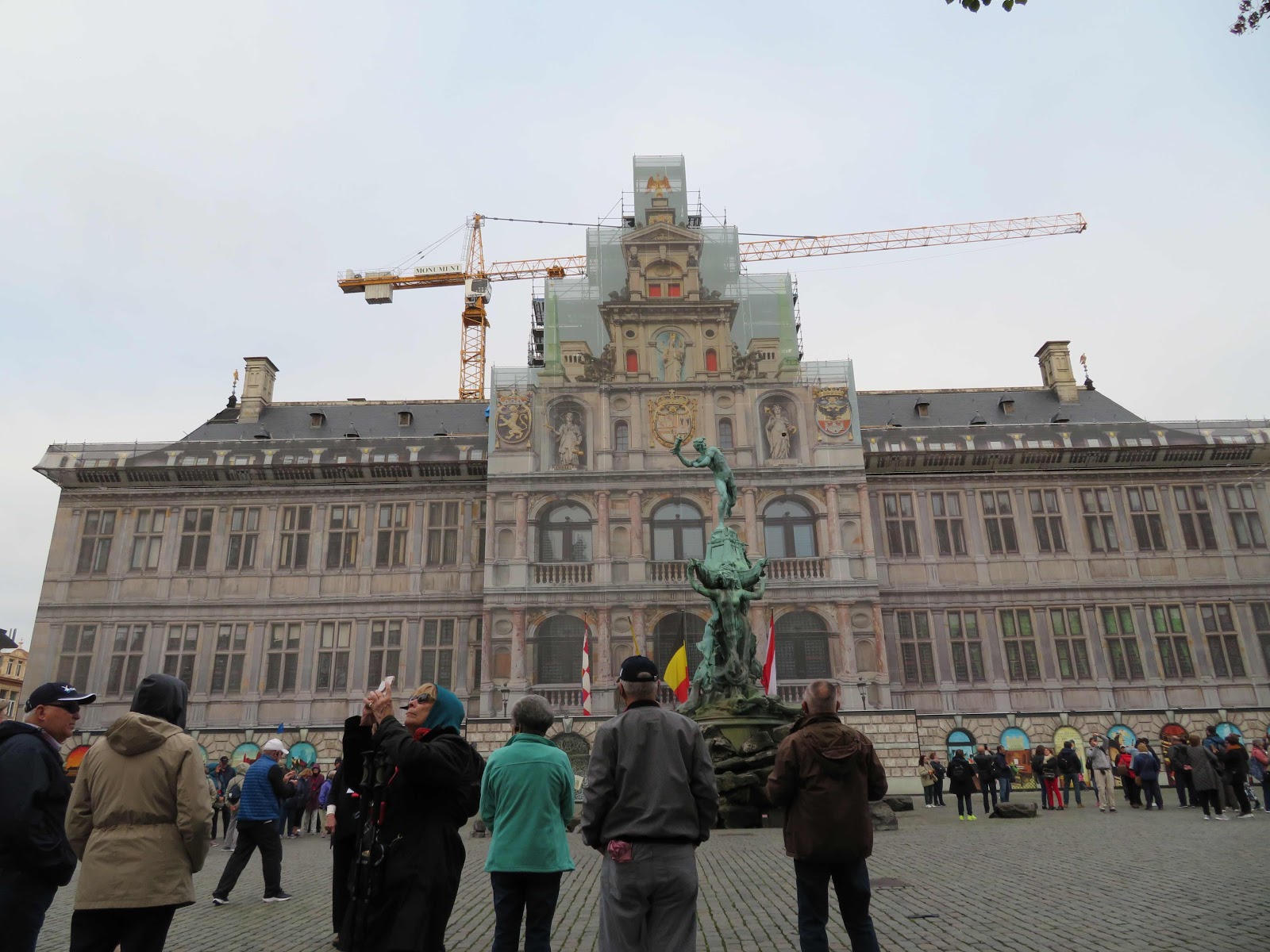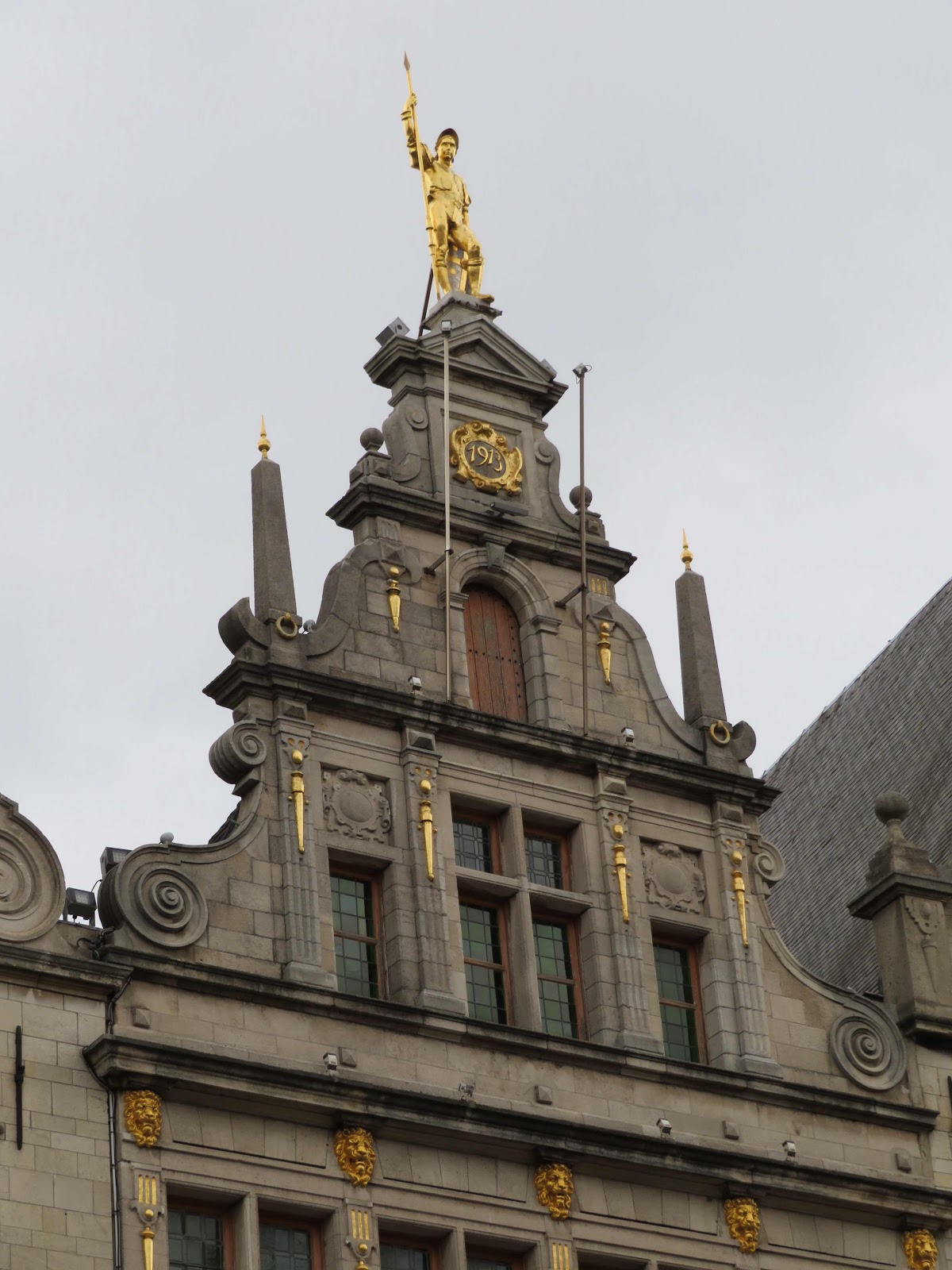10/12/2019 Antwerp, Belgium • Ave Temp. 60 high 47 low. Ave. weather - 44% mostly cloudy 28% rain. Phone says 15,911 steps for 6.7 miles and 5 floors climbed.
• Included Meals: Breakfast, Lunch, Dinner • Accommodations: River Ship
Tour info “Set off on a walking tour of Antwerp. You’ll explore the city’s well-preserved Old Town, built around the Grote Markt (Town Square), and graced by the lovely old Town Hall and beautiful guild houses. Or, marvel at the elegant spires of the Cathedral of Our Lady, or stroll along the Meir, Antwerp’s main shopping street, lined with historic buildings.
Your afternoon is free to further discover the city on your own. You may want to visit the house of the great painter Peter Paul Rubens. He purchased a 16th-century residence off the Meir when he returned from Italy in 1608 and transformed it into one of the most elegant Renaissance-Baroque houses in the Low Countries. Today it is a museum, housing Rubens’s self-portrait, as well as pieces by some of his contemporaries. Or you could visit the Rockox House, an art history museum and garden featuring Flemish paintings, sculptures, and furniture from the beginning of the Dutch Golden Age.
Gather this evening for the Captain’s Farewell Drink and Dinner to toast a memorable River Cruise with your fellow travelers.”
My info
Grote Markt (Town Square) offers Renaissance architecture in the center of Old Town. The elaborate Town Hall (Stradhuis) and guildhalls from the 16th century are on the square.
 Guild Houses were identifiable by the statuary on the peak of the building.
Guild Houses were identifiable by the statuary on the peak of the building.
 They paid to have the building recreated on the screening being used during refurbishing. So all that you see is covering the scaffolding.
They paid to have the building recreated on the screening being used during refurbishing. So all that you see is covering the scaffolding.


 Peaks of guild houses.
Peaks of guild houses.
Two of the guides are from Antwerp and one of them gave us a tour of the cathedral. The Royal Museum is bing renovated so more masterpieces are on display there. The artwork was quite amazing.
My info
Antwerp is the most populated city in Belgium and is a port city dating back to the Middle Ages. The Diamond District is renowned with thousands of traders, cutters, and polishers. The port of Antwerp is one of the largest in the world and ranks second in Europe. The world's oldest stock exchange building was built in 1532 and rebuilt in 1872. Most diamond stores are closed on Saturday.
Grote Markt (Town Square) offers Renaissance architecture in the center of Old Town. The elaborate Town Hall (Stradhuis) and guildhalls from the 16th century are on the square.
The Renaissance-style Stradhuis (Town Hall) was built between 1561 and 1565 and is a UNESCO site. The second and third stories have Doric and Ionic columns and the fourth story is an open gallery. Painters created murals depicting Antwerp’s history. This building was the inspiration for the Hague and other Rathauses. Most of the year, flags of the European Union are decorating the facade.
The Brabo Fountain in front comes from a Middle Ages legend. Silvius Brabo killed a Russian giant Antigoon that exacted tolls of sailors passing by on the river. If the sailors could not pay, the giant cut off their hands and threw the hands in the river. Brabo cut off the giant’s head and threw his hands in the river. The Hand symbol is still displayed on the city’s seals and coat of arms throughout the town and symbolizes the free waterway. The fountain shows Brabo throwing the giant’s hand in the river. Sea animals surround the pedestal Brabo stands on and mermaids support a castle symbolizing the city. The giant’s head dangles below Brabo’s feet.
Below you can’t see Brabo is throwing a hand in the river, but if you look just below the foot Brabo is standing on, you can see the giant’s head. Just above the pile of rocks is the giant’s headless body. Pretty grim...
Guild Halls were historically used by guilds for meetings and other purposes. Many are now museums. Originally guilds were organized groups of merchants, as far back as Roman times. Medieval merchant guilds controlled the way the trade was conducted in their region. Guild Halls were used to store goods and for celebrations. Guild members often cleaned streets, removed trash, were night watchmen and helped the poor.
The Cathedral of Our Lady of Antwerp is a Gothic-style Roman Catholic cathedral. Construction began in 1352 and it has never been “completed”. The finished spire measures 123 meters (404 ft). Sixteen ringers are needed to ring the largest bell (14,185 lbs.) in the tower. The carillon has 49 bells. The South Tower measure 214 ft and the Central Tower is 92 feet. Stained glass windows depict Our Lady of Stekske, Saint Ursula and Saint Gaspar, and Dedication of the statue of Our Lady of Lourdes. There are 55 stained-glass windows of 128 total, seven aisles, and 125 pillars. The Schyven organ has 90 registers and 5,770 pipes. Maintenance costs 1.5 million euros per year. Several of Rubens works are there with van Veen, de Backer and de Vos. The belfry is on the UNESCO list. There is quite a list of important composers and organists that have worked with the choir beginning in 1443.
Meir is a wide street of comercial importance and the site of many parades and events. It is the region’s prime shopping street. There is an interesting collection of architectural styles. Find the Royal Palace, the Stadsfeestzaal, the domed Innovation building and the Osterrieth House, a Rococo-style mansion. Look for statues on the tops of the buildings. Leysstreet is an extension of the Meir with more elaborate buildings. Rubens House is nearby.
Sint Anna Tunnel was built between 1931 and 1933. It is 1800 feet long and pedestrians and bicyclists can safely travel to the other side of the Scheidegg river.
This is the rickety escalator I rode down to the tunnel.
| Tunnel under the river for bikes and walkers. |
My ship across the river.
| St.Charles Borromeo |
Another amazing church in Antwerp. St. Charles Borromeo built by the Jesuits in 1600’s. It was saved in the Reformation of William of Orange because the parishioners had enough money to purchase the church.
Going to Bruge tomorrow for three nights.
No comments:
Post a Comment